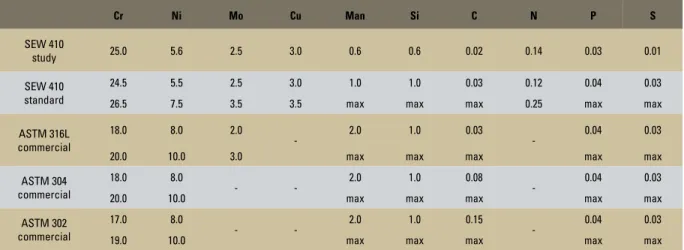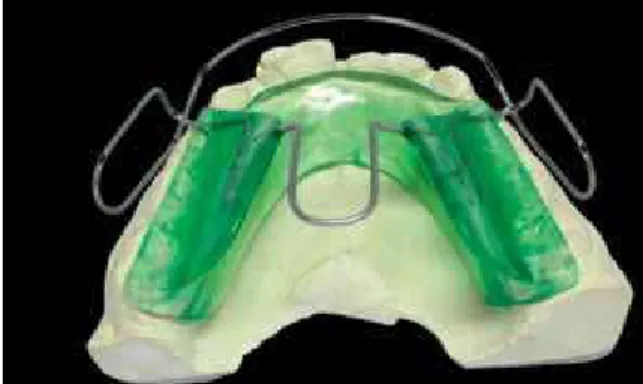A new stainless steel wire for
orthodontic purposes
André Itman Filho*, Rosana Vilarim da Silva**, Roney Valdo Bertolo***
Objective: To develop a method to manufacture austenitic-ferritic stainless steel orth-odontic wires (SEW 410 Nr. 14517) using conventional rolling and wiredrawing pro-cesses. Methods: Austenitic-ferritic steel was produced in an induction furnace. Tensile tests and microhardness measurements were used to evaluate the wires quality. Orth-odontic components were fabricated to assess ductility and malleability. Results and Conclusions: Austenitic-ferritic stainless steel wires meet the BS 3507:1976 and ISO 5832-1 standards and have excellent ductility for the fabrication of orthodontic parts with complex folds.
Abstract
Keywords: Duplex stainless steel. Orthodontic wire. Orthodontic wire properties.
intROduCtiOn
The practice of surgical implants was already known in the beginning of the Christian era, al-though the first documented case in 1565 was the restoration of a patient’s palate using a gold plate.13 Although in use since the 16th century,
little is known about the fabrication and quality of the elements used in these procedures. It was only after 1895, when it became possible to visu-alize metal fixation and bone healing of fractures
using X-rays, that the use of metal biomaterials in human implants received greater attention. At first, gold alloys, silver and platinum were used because of their high degree of biocompatibil-ity and malleabilbiocompatibil-ity.12,15 Since 1930, metal alloys
containing nickel, cobalt, chromium and molyb-denum have been used to manufacture partial dentures. The combination of low cost and good mechanical properties made them a good replace-ment for nobler metals.10,11 These alloys, called
» The authors report no commercial, proprietary, or inancial interest in the
products or companies described in this article.
How to cite this article: Itman Filho A, Silva RV, Bertolo RV. A new
stain-less steel wire for orthodontic purposes. Dental Press J Orthod. 2011 July--Aug;16(4):55-9.
basic, require high fusion temperatures and spe-cial equipment for surface finishing of the prod-ucts manufactured. Alloy metallurgy used to be extremely complex, and the chances of success depended on important variables, such as the ap-propriate chemical composition of the material and the evaluation of its mechanical properties, as well as knowledge about casting techniques.4,13
In the same technological field, these nonferrous alloys have been gradually replaced with ASTM 300 austenitic stainless steel for orthodontic pur-poses. This type of steel, in addition to having a lower density than basic alloys, feature appro-priate mechanical strength, good resistance to corrosion and sufficient biocompatibility at a lower cost.1,9,12 In orthodontic treatments, metal
wires undergo mechanical strains resulting from mastication, which produces permanent defor-mation and localized residual stresses. There-fore, the mechanical resistance of wires should be high enough to undergo plastic deformation because they will be exposed to the stresses of joint movements. The ASTM 302 and ASTM 304 types of steel are the most commonly used, whereas the austenitic ASTM 316L stainless steel is more appropriate for surgical implants (Table 1). Currently, knowledge of the mechan-ical properties of the several alloys may lead
to the optimization of orthodontic treatments. In general, wires manufactured using austenitic stainless steel are appropriate for use in the final stages of treatment due to their excellent rigidity and resistance to corrosion in the oral environ-ment.3,5,8 Other properties, such as toughness,
fa-tigue resistance and ductility contribute to their choice as the most adequate material for these uses. The ideal alloy should be sufficiently resis-tant to withstand the strains of joint movements, capable of absorbing mechanical impact without plastic deformation, inert to organic fluids and not release toxic products.2
Because of its mechanical and corrosion resis-tance, austenitic stainless steel has been replaced with austenitic-ferritic stainless steel in several industrial applications that require better resis-tance to stress-corrosion cracking.6,14 Results in
the literature also show that the biocompatibility of austenitic and austenitic-ferritic steel is similar.1
In the case of orthodontic treatments, the replace-ment of austenitic stainless steel with austenitic-ferritic steel reduces costs and nickel hypersensi-tivity to patients.
OBJECtiVE
In this study, austenitic ferritic stainless steel (SEW 410 Nr. 14517) wires were fabricated using
TABLE 1 - Chemical composition (% of weight) of the following stainless steel, mentioned in the text: standard SEW 410 Nr. 14517, austenic-ferritic and austenitic.
Cr Ni Mo Cu Man Si C N P S
SEW 410
study 25.0 5.6 2.5 3.0 0.6 0.6 0.02 0.14 0.03 0.01
SEW 410 standard
24.5 5.5 2.5 3.0 1.0 1.0 0.03 0.12 0.04 0.03
26.5 7.5 3.5 3.5 max max max 0.25 max max
ASTM 316L commercial
18.0 8.0 2.0
- 2.0 1.0 0.03 - 0.04 0.03
20.0 10.0 3.0 max max max max max
ASTM 304 commercial
18.0 8.0
- - 2.0 1.0 0.08 - 0.04 0.03
20.0 10.0 max max max max max
ASTM 302 commercial
17.0 8.0
- - 2.0 1.0 0.15 - 0.04 0.03
rolling and wiredrawing, processes that are similar to those used to manufacture commercial stainless steel austenitic wires used in orthodontic treat-ments. This duplex steel was chosen because it is very used in several industrial applications. To check whether the fabricated wires met the stan-dards, tensile tests and microhardness measure-ments were used. Material ductility was evaluated using fractographic analyses and by means of fabri-cating orthodontic components.
EXPERiMEntAL PROCEduRES
Austenitic-ferritic steel was prepared in a 500-kg induction furnace in Grupo Metal (Tietê, São Paulo, Brazil). Liquid metal was poured into an agglomerate sand mold with phenolic urethane resin binder in the form of a keel block (ASTM A781-M) adapted to the commercial compo-nent. The chemical composition of steel was de-fined by means of analysis using optical-emission spectrometry. The starting bar measured about ø11x180 mm in length. It was milled using a me-chanical lathe to a diameter of 10 mm and later reduced to a diameter of 2.5 mm by rolling pro-cess. The rolled wires were about 1 meter long and were soldered to the ASTM 304 stainless steel wire and reduced to a diameter of 0.4 mm ac-cording to conventional cold drawing performed in Superfine Steel (Santa Bárbara D’Oeste, Bra-zil). To evaluate the tensile strength, wire samples cut during wiredrawing underwent tensile tests in a universal testing machine (EMIC DL 10000) at 1 mm/min strain rate according to the ASTM E 8-00 and NBR 6152/92 standards. These sam-ples were also used for microhardness measure-ments according to the criteria established in the ASTM E384-89 standard. Orthodontic compo-nents were fabricated to evaluate wire malleabil-ity in comparison with commercial stainless steel wires. To check the morphological fracture char-acteristics after the tensile test, a sample of the wire with 0.9 mm in diameter was analyzed under scanning eletron microscope.
RESuLtS
Values shown as weight percentages in Table 1 revealed that the element contents met the chem-ical composition specifications for austenitic-fer-ritic stainless steel (SEW 410 Nr. 14517).
Table 2 shows mean values of ultimate tensile strength and standard deviations after trials with five specimens. These values meet the require-ments of the BS 3507:1976 and ISO 5832-1 stan-dards. The same table shows the microhardness values of the samples used in the tensile tests.
Figure 1 shows a Bionator manufactured using austenitic-ferritic stainless steel wires. Figures 2A, 2B and 2C show representative fractographic fea-tures of a sample that underwent tensile testing.
diSCuSSiOn
The greatest difficulty in this study was to de-velop a wire manufacturing process in convention-al equipment used for large amounts of matericonvention-al, differently from our initial austenitic-ferritic steel sample, which weighed about 500 g. In general, furnace fusions are run for at least 500 kg of steel, which makes it very expensive to obtain material for research purposes. Therefore, to obtain an ini-tial austenitic-ferritic stainless steel sample it was
TABLE 2 - Ultimate tensile strength and Vickers microhardness of wires manufactured using SEW 410 Nr. 14517 steel.
FIGURE 1 - Bionator manufactured using SEW 410 Nr. 14517 steel wire.
ø 2.5 mm ø 1.1 mm ø 0.9 mm ø 0.4 mm
σt (MPa) 1,423±16 1,596±26 1,726±41 2,030±25
A B C
FIGURE 2 - Fractograph of Ø 0.9 mm wire that underwent tensile testing in different magnifications: A) surface of wire fracture; B, C) enlargement of region shown in (A).
necessary to adapt a keel block mold to the com-mercial specimen. The reduction down to a diam-eter of 2.5 mm was made in a laboratory, and wires of about 1 m in length were obtained. Industrial wiredrawing uses longer lengths to start the pro-cess. Therefore, ø 2.5 mm wires had to be soldered to ASTM 304 stainless steel wires, whose compo-sition is compatible with that of austenitic-ferritic steel. The effect of the high degree of cold defor-mation during the shaping stages is described in Table 2, which shows a reduction of 80.2% in the last wiredrawing pass (ø 0.9 mm → ø 0.4 mm). Despite the significant increase of hardness in the final diameter after wiredrawing, there was no loss of ductility or malleability, which was confirmed by the fact that several parts with different folds were manufactured without any wire break. High mechanical resistance and hardness, a characteris-tic of stainless steel, are important parameters to ensure that the wire will keep teeth in the cor-rect position after the conclusion of orthodon-tic treatments. Moreover, the shaping process to achieve the desired diameter was similar to that used in the fabrication of commercial stainless steel wires, which favors large-scale production without changes in steel manufacturing processes. The val-ues of hardness and tensile strength, similar to those of commercial stainless steel orthodontic
wires (ASTM 302 and ASTM 304), are an indica-tion that steel can resist to the wear of wire move-ments between brackets, and that its properties are adequate for use in orthodontics according to the BS 3507/1976 and ISO 5832-1 standards. Steel ductility was confirmed in Figure 2, which shows the classic cone-cup pattern, in which the crack starts in the center of the wire, it propa-gates along the edge and fractures by shearing.7
The evaluation of wire malleability revealed that the austenitic-ferritic stainless steel has adequate ductility for intense folding, as required in the fabrication of bionators, and it is appropriate for the fabrication of other orthodontic components as well. The comparison with commercial austen-itic stainless steel wires used in routine procedures did not reveal any differences in the handling of the two types of wire.
COnCLuSiOn
REfEREnCES
Contact address André Itman Filho
Rua José Teixeira, 228, apto. 1102 – Praia do Canto CEP: 29.055-310 – Vitória / ES, Brazil
E-mail: andreitman@hotmail.com Submitted: March 23, 2006.
Revised and accepted: December 02, 2009
1. Beloti MM, Rollo JMDA, Itman A, Rosa AL. In vitro biocompatibility of duplex stainless steel with and without 0,2% niobium. J Appl Biomater Biomech. 2004;2(3):162-8. 2. Dainesi EA, Dainesi EA, Consolaro A, Woodside DG, Freitas
MR. Nickel hypersensitivity reaction before, during and after orthodontic therapy. Am J Orthod Dentofacial Orthop. 1998;113(6):655-60.
3. Drake SR, Wayne DM, Powers JM, Asgar K. Mechanical properties of orthodontic wires in tension, bending, and torsion. Am J Orthod. 1982 Sept;82(3):206-10. 4. Felton DA, Brien RL. Comparison of titanium and
cobalt-chromium removable partial denture clasps. J Prosthet Dent. 1997;78(2):187-93.
5. Finn ME, Srivastava AK. Machining of stainless steel. Proceedings of the International Conference on Manufacturing of Advanced Materials. Las Vegas; 2000. 6. Gunn RN. Duplex stainless steel: microstructure, properties and
applications. Cambridge: Cambridge University Press; 1997. 7. Hull D. Fractography. Cambridge: Cambridge University
Press; 1999.
8. Kapila S, Sachdeva R. Mechanical properties and clinical applications of orthodontic wires. Am J Orthod Dentofacial Orthop. 1989;96(2):100-8.
9. Padilha AF, Guedes LC. Aços inoxidáveis austeníticos: microestruturas e propriedades. São Paulo: Hemus; 1994. 10. Ratner BD. Biomaterial science introduction to materials in
Medicine. New York: Academic Press; 1997.
11. Rubin L. Biomaterials in reconstructive surgery. St. Louis: CV Mosby; 1983.
12. Silva ALC, Mei PR. Aços e ligas especiais. Sumaré, SP: Eletrometal S.A. Metais Especiais. 2ª ed. São Paulo: Pannon; 1988.
13. Skinner EW. Materiais dentários. 9ª ed. Rio de Janeiro: Guanabara Koogan; 1991.
14. Truman JE, Pirt KR. Properties of a duplex (austenitic-ferritic) stainless steel and effects of thermal history. Duplex Stainless Steel Conference Proceedings. 1983 Oct 23-28. Metals Park: American Society for Metals; 1983. p. 113-42. 15. Willians DF, Roaf R. Implants in surgery. London: W. B.


